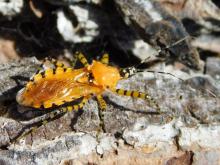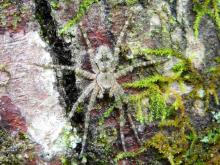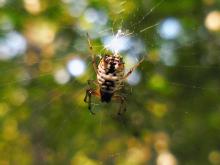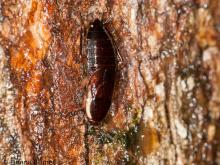Land Invertebrates
Media
Species Types
Scientific Name
About 11 species in North America north of Mexico
Description
Mantidflies look like a cross between a lacewing insect and a praying mantis. They are small, delicate creatures with intricately veined wings, but the front half looks like a mantid, complete with raptorial forelegs.
Media

Species Types
Scientific Name
Pselliopus barberi
Description
The orange assassin bug, Pselliopus barberi, is about ½ inch long and is one of our most attractive non-butterfly insects. They overwinter in groups as adults under loose bark.
Media

Species Types
Scientific Name
Dolomedes albineus
Description
Whitebanded fishing spiders are often seen on tree trunks, walls, or other vertical surfaces, sometimes far from water. The coloration and markings can vary, but many individuals have an olive-green cast that helps them blend in with mosses and lichens. Note the bristly legs.
Media

Species Types
Scientific Name
About 2,000 species in North America north of Mexico
Description
Plant bugs, or mirids, are a huge family of true bugs. They are often overlooked — except by gardeners and farmers. Most mirids eat plants, and some are agricultural pests. As a group, they’re an important food source for birds and other insectivores.
Media

Species Types
Scientific Name
Schistocerca spp.
Description
About six species of bird grasshoppers occur in Missouri. Most are attractively marked, large insects that gracefully fly from danger, almost like birds.
Media

Species Types
Scientific Name
Myzinum quinquecinctum
Description
Female and male five-banded thynnid wasps look quite different. Both are banded with black and yellow, but the females are large and heavy-looking, while the males, often seen in groups, are much skinnier and have a scythe-shaped false stinger on the hind end.
Media

Species Types
Scientific Name
Vespa crabro
Description
The European hornet is a large, nonnative hornet that was introduced to New York in the mid-1800s. They now occur across most of the eastern United States, including Missouri. People may misidentify them as the highly publicized, so-called murder hornets.
Media

Species Types
Scientific Name
Micrathena mitrata
Description
The white micrathena has 2 short pairs of tubercles and a white abdomen with a few distinct black blotches on the upper side. In an odd way, it looks like it's wearing a turban. This is one of three Missouri species of micrathenas, also called spiny orbweavers.
Media

Species Types
Scientific Name
Apis mellifera
Description
The honeybee is a major pollinator of many field crops and tree fruits. Native to the Old World, it is not native to North America. In 1985 it was named the official state insect of Missouri.
Media

Species Types
Scientific Name
Over 100 species of cockroaches and termites in North America north of Mexico
Description
Cockroaches well-known: they are flattened, small, brown or black, often shiny insects that can hide in tight crevices and lack specialized appendages. Recently, termites have been included in their order.
See Also



Media

Species Types
Scientific Name
Cisseps fulvicollis
Description
The yellow-collared scape moth is more often “orange-collared.” And whether you think it looks more like a firefly or a wasp, it’s still a moth!
Media

Species Types
Scientific Name
Nearly 150 species in North America north of Mexico
Description
Slim, delicate plume moths are instantly recognizable by their T-shaped silhouette, long legs, and muted shades of tan and brown. It can be hard to separate the various species.
Media

Species Types
Scientific Name
Pyrrharctia isabella
Description
Not many people know the adult Isabella tiger moth when they see one, but we’re all acquainted with its caterpillar, the woolly worm, or woolly bear.
About Land Invertebrates in Missouri
Invertebrates are animals without backbones, including earthworms, slugs, snails, and arthropods. Arthropods—invertebrates with “jointed legs” — are a group of invertebrates that includes crayfish, shrimp, millipedes, centipedes, mites, spiders, and insects. There may be as many as 10 million species of insects alive on earth today, and they probably constitute more than 90 percent all animal species.





















